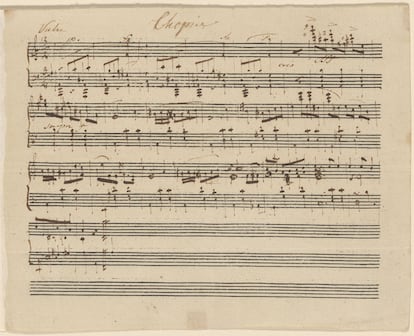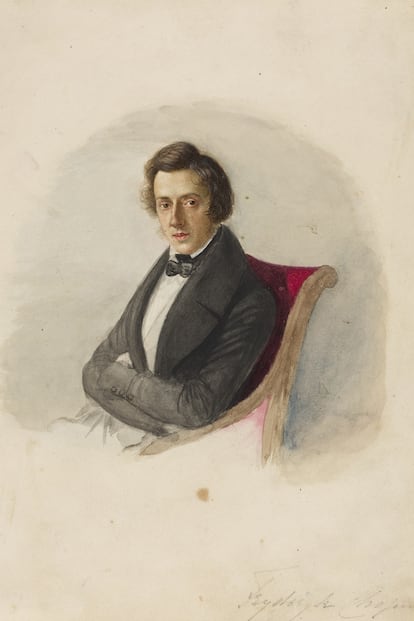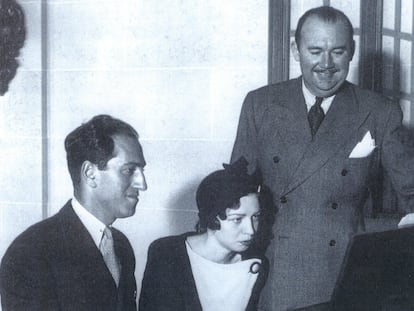The questions surrounding the Chopin waltz unearthed in a New York library
The director of the Chopin Institute in Warsaw believes the strange work stems from the Polish composer’s teaching activities, as studies suggest it dates back to around 1830 and matches his handwriting

The scores of piano waltzes by Frédéric Chopin have been the source of paranormal stories. One of the most notable is recounted in Chopin and Beyond: My Extraordinary Life in Music and the Paranormal, a 2010 book by the celebrated American pianist Byron Janis and his wife, Maria Cooper Janis, daughter of actor Gary Cooper.
Janis, who passed away seven months ago at the age of 95, claimed he discovered two previously unknown signed scores of Chopin’s waltzes Opus 18 and 70/1 at France’s Château de Thoiry in 1967, guided, as he believed, by telepathy. In a striking synchronicity, six years later he encountered two more signed scores of the same waltzes at Yale University. This mysterious experience sparked wide interest, inspiring a French documentary and even prompting Martin Scorsese to announce plans to make a film.
Both of Janis’s discoveries made a significant media splash, with The New York Times featuring one of the autographs found in France on its front page, accompanied by an in-depth article by critic Harold Schoenberg.
Just recently, on Monday, October 28, another Chopin manuscript appeared on the front page of the same newspaper under the headline, “Chopin Waltz Is Unearthed.” The article recounts the discovery by a curator at the Morgan Library and Museum in New York of a completely unknown waltz by the Polish composer. Though the composition is brief, it has sparked debate among experts. Artur Szklener, director of the Fryderyk Chopin Institute in Warsaw — dedicated to researching and promoting the composer’s life and work — suggests it could be a trace of Chopin’s teaching, a musical jest, or even a piece created to make ends meet. The New York Times website now offers a video of the piece performed by the renowned pianist Lang Lang.
The discovery of Chopin’s autograph manuscripts ties back to the composer’s habit of gifting these waltzes to his students and friends. Due to their brevity and accessible musicality, they were often copied onto an album sheet. Krystyna Kobylańska’s comprehensive 1977 catalog of Chopin’s manuscripts highlights this trend: it documents 564 autograph manuscripts and 616 copies annotated by Chopin within a catalog of 338 works.
One of the most illustrative examples is the melancholic Waltz in F Minor, Op. 70, No. 2. Although Chopin never published it during his lifetime, he frequently gifted copies of it. This is evident from the 14 signed copies that have survived, each dedicated to various students and prominent women in society, including Élise Gavard, Maria Krudner, and Charlotte de Rothschild.

The newly discovered waltz has no dedication. It also does not follow a conventional structure: it has only one section and ends with an indication of a possible reprise. What’s more, with just 24 bars, it is the shortest Chopin waltz. It may also be the strangest. The piece opens with dissonant chords building in crescendo to a fortississimo (fff) marking — a dynamic not found in any other Chopin waltz — before leading into a melody with Chopin’s signature ornamentation and accompaniment. Despite these elements, the piece has been described as musically unremarkable; in The New York Times article, musicologist John Rink refers to it as a “creative outburst,” while pianist Stephen Hough dismisses it as a “trifle.”
The manuscript was part of the autograph collection of A. Sherrill Whiton Jr., director of the New York School of Interior Design and an amateur pianist. The Morgan Library and Museum acquired it in 2019, as part of its legacy that is in the process of being cataloged. The team of experts at this research center — which has around 20 Chopin manuscripts— has tentatively dated the piece to the 1830s, though they acknowledge that Chopin’s name was added later. The center has reported that the musical calligraphy matches Chopin’s, as it includes his personal way of drawing the bass clef.
Artur Szklener, director of the Chopin Institute, does not rule out this possibility, but has expressed some reservations. Chopin’s notation is generally more refined, and his friend, composer Julian Fontana, drew the bass clef in a similar way, often leading to past confusions between their manuscripts.
Fontana was a classmate of Chopin in Warsaw, and had also gone into exile in Paris in the 1830s following Poland’s November Uprising against Russian rule. In Paris, Fontana became one of Chopin’s closest collaborators and ultimately his musical executor after Chopin’s untimely death in 1849 at the age of 39. Fontana took on the task of posthumously publishing much of Chopin’s work, including the waltzes Op. 69 and 70 in 1855. Fontana added variant editions to these that some specialists consider to be unrelated to Chopin, after comparing them with the composer’s autographs.
Chopin’s piano waltzes were not dance pieces, but rather salon music. However, the Pole gave them such brilliance, elegance, lyricism and spontaneity that they transcended typical salon compositions and were considered notable artistic achievements. While Chopin is known to have composed around 30 waltzes, only 19 have survived in full. Of six of his last waltzes, only the opening phrases (incipits) remain, having been copied by his sister Ludwika Jedrzejewicz. She had taken these autographs to Warsaw, where they were ultimately lost in the 1863 fire that destroyed the Zamoyski Palace.
Chopin published eight waltzes during his lifetime (opus 18, 34, 42, and 64) among which is the immensely popular The Minute Waltz, which Barbra Streisand used on her album Color Me, Barbra. It was also used in The Muppets and in several television commercials. Following these, five additional waltzes were published posthumously by Fontana (opus 69 and 70), alongside two others: one designated as opus posthumous and another in E major, which was released in 1861 without a specific catalog number.
The remaining four waltzes were printed long after Chopin’s death and are typically identified by their catalog numbers from Maurice Brown (B.) or Krystyna Kobylanska (K.K.). These include two waltzes sent to his teacher Józef Elsner, published in 1902 by his wife Emilia (B. 21 and 46), though their original manuscripts were destroyed during World War II. Another waltz, dated July 1848 and dedicated to his friend and pupil Émile Gaillard, was published in 1955 (B. 133). Additionally, the exquisite late Waltz in A minor (B. 150), written for Charlotte de Rothschild, also saw publication in 1955 in La Revue musicale.
None of the 19 published waltzes can be compared in quality or craftsmanship to the one recently “unearthed” at the Morgan Library and Museum. The director of the Chopin Institute regards it merely as a trace of Chopin’s activity as a pianist, possibly written during his early years in Paris. He does not believe it qualifies as the 20th waltz in Chopin’s catalog. It’s conceivable that this sketch may eventually be proven not to be Chopin’s at all, which is what happened in 2012 with the Valse mélancolique in F-sharp minor. Initially published in 1861, this piece was later found to actually be a composition titled Le Régret by the Prussian pianist Charles Mayer
Sign up for our weekly newsletter to get more English-language news coverage from EL PAÍS USA Edition
Tu suscripción se está usando en otro dispositivo
¿Quieres añadir otro usuario a tu suscripción?
Si continúas leyendo en este dispositivo, no se podrá leer en el otro.
FlechaTu suscripción se está usando en otro dispositivo y solo puedes acceder a EL PAÍS desde un dispositivo a la vez.
Si quieres compartir tu cuenta, cambia tu suscripción a la modalidad Premium, así podrás añadir otro usuario. Cada uno accederá con su propia cuenta de email, lo que os permitirá personalizar vuestra experiencia en EL PAÍS.
¿Tienes una suscripción de empresa? Accede aquí para contratar más cuentas.
En el caso de no saber quién está usando tu cuenta, te recomendamos cambiar tu contraseña aquí.
Si decides continuar compartiendo tu cuenta, este mensaje se mostrará en tu dispositivo y en el de la otra persona que está usando tu cuenta de forma indefinida, afectando a tu experiencia de lectura. Puedes consultar aquí los términos y condiciones de la suscripción digital.









































